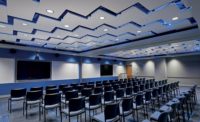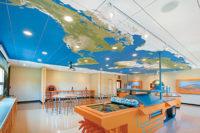As part of a new 16-story, multi-use residence hall in the heart of Boston, the Berklee College of Music desired a space that would serve as a dining area during the day and a performance venue for the students at night. Because of this dual function, both aesthetics and acoustics were key considerations in its design.
To meet the challenge, the design team at William Rawn Associates, architects in Boston created the “Caf,” a two-story, 400-seat space featuring a 32-foot high ceiling, a gracefully curved second floor balcony, and a floor-to-ceiling glass wall overlooking busy Massachusetts Avenue. According to Designer Brian Putnam, the design team wanted to impart a dynamic quality to the space to complement its urban setting.
Eye-catching Red Ceiling
One way the team accomplished its goal was the use of MetalWorks Torsion Spring panels from Armstrong Ceiling Solutions in a custom red color in the ceiling and custom MetalWorks WH100 panels on the wall. “Red was chosen because it’s the school color and both eye-catching and highly visible from the street,” Putnam states.
MetalWorks panels were selected for the ceiling and wall because of their high tech, sophisticated look. The light weight of the aluminum panels and their durability were also considerations. “Torsion Spring panels were chosen for the ceiling because they have no exposed grid and still allow accessibility where needed,” Putnam adds.
The ceiling panels are installed in a series of clouds high above the dining and performing area. According to Mark Allan of Allan Construction of Salem, NH, the acoustical contractor, one of the more difficult aspects of installing the clouds was working around the myriad of building services above the clouds.
“Because of its dual function as a cafeteria and a performance space, we not only had to bridge and straddle the normal services to hang the suspension systems, but also all the sound and lighting equipment required for the performance area below,” he says.
The shapes of the ceiling clouds mirror the balcony’s “ribbon wall,” a 201-foot-long wall featuring sweeping curves designed to redirect sound. “We needed to deflect sound so that it did not bounce straight back to the glass wall behind the performers,” Putnam explains. All of the metal panels in the ceiling and wall are perforated and backed with a fiberglass infill for acoustic control.
Custom-sized Wall Panels
The “ribbon wall” consists of three rows of metal panels stacked on top of each other. Because of the wall’s curved design, all the panels had to be custom sized at the manufacturing plant. The panels are all the same height but have different widths depending on the radius and arc length. Some panels are only a foot wide in order to traverse a tight curve.
“Because the panels were custom sized at the plant, field measurements were critical,” states Allan. “That’s because each panel had to be in its precise location or we’d end up with a tolerance build-up and eventually require infill panels. In addition, to meet the design intent of the architect, all the joints had to be tight with no space between them, no gaskets, and no lipping.”
The radial portions of the wall also required a change in the attachment method. Working together, Allan Construction and Armstrong tested different installation options instead of a bolted system and decided on a hook-on system with custom angled panel edges. In total, 350 panels were then installed.
“To create the space we desired, we knew we would be heavily reliant on the ceiling and wall surfaces, both in terms of aesthetics and acoustics,” Putnam states. “It’s amazing how much of a signature element they have become.”
(The Berklee College of Music project won Gold in the Interior Finishes category, East Region, of the 2015 Construction Excellence Award competition of CISCA.)





Report Abusive Comment